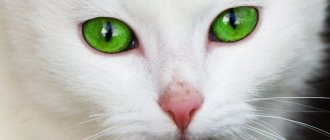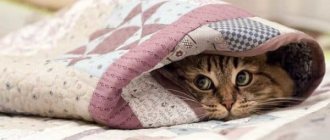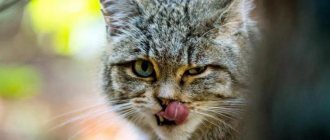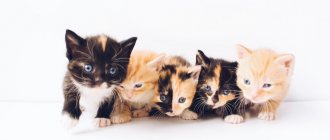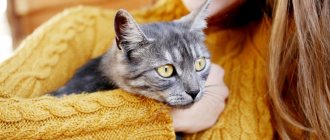Responsible cat owners are aware of their pet's age. Some followed the pedigree for sure, while others simply remembered that this cat was picked up on the street in such and such a year. A person has an idea of what lifestyle is typical for childhood, growing up, maturity and old age. Apparently, the same stages are characteristic of a cat’s life path.
But how to compare the age of the pet and the owner? When do cats end their childhood? What age should be considered maturity, and when do animals become old? This article answers the questions.
Odds table
The most popular method is to use a coefficient table. This is a special number that approximately determines how many human years pass while a pet lives 1 year.
It is incorrect to compare the psychological characteristics, logic and thinking of cats and people, so scientists have created a special plate showing the ratio of cat and human ages:
This plate allows you to find out how old the cat is by human standards. If the exact age is unknown, any veterinarian can determine it (by the animal’s teeth and the general condition of the body).
The coefficient shows only the rate of aging of the cat’s body, and not at all the formation of its intelligence.
Poorly influencing factors on a cat's age
If you provide your pet cat with decent care and proper nutrition, eliminating harmful foods from the diet (cheese, sweets, salty, spicy, etc.), then the duration can increase significantly.
However, there are some factors that have a negative impact on the “human” age of a pet, these include the following:
- feeding the cat “from the table”;
- lack of routine vaccinations and antiparasitic medications;
- using medications to suppress sexual desire;
- abuse of sedatives (calming) drugs;
- lack of cat care - combing, cleaning eyes, ears, teeth.
Attention! Before reaching a two-year period, it is difficult to influence the animal’s condition in any way; at this time, the main thing is to prevent diseases and stress in a young cat in time.
Age ratio
The age of cats in human terms can be determined using a ratio. With this calculation option, one year of a pet’s life should be equated to a certain number of years of a person’s life. Example:
- 15 human years is 1 year of a cat’s life;
- 24 human years is the second year of a cat’s life;
- Then, each year of the cat’s life adds 4 human years to its age, until the figure reaches 16 years;
- After this period, each year is equivalent to 3.
In this way, you can track the maturation of the cat. A two-year-old cat and a 24-year-old guy can easily be considered peers. At this age, the pet's character is already fully formed.
© shutterstock
Age-related diseases usually begin by age 15 (76 human years for a cat). The pet's behavior also changes significantly:
- Interest in any cat games decreases sharply;
- Drowsiness appears;
- Diseases associated with wear and tear on the body may begin.
Age characteristics, behavior and character can be influenced by the breed of the animal.
Life expectancy of cats
When considering how many years cats live on average, it is worth paying attention to the conditions of their keeping and feeding habits. Thus, domestic pets have a life expectancy that is many times higher than that of stray animals. Of course, if the owner follows the rules of care. Stray cats only live 3-5 years. But in home conditions and with proper maintenance, especially for exotic breeds, an animal can live more than 10-15 years. Long-living domestic cats are also known.
When looking at the lifespan of animals, a cat is found to live longer than a dog. In the latter, life expectancy depends on the breed and size. For example, small dogs live longer than large ones.
Factors influencing the lifespan of an animal:
- Balanced nutrition, tailored to the age of the pet. A lack of vitamins and nutrients can cause the development of diseases, which in turn reduce life expectancy.
- An active lifestyle can improve health and prolong life.
- No or minimal stress.
- Regular visits to the veterinarian, timely vaccination and preventive examination - all this reduces the likelihood of the appearance and development of various diseases.
- Affection and love for an animal significantly prolongs the life of a pet.
Thus, the article examined how the age of a cat is correctly calculated in human equivalent, myths regarding the number of lives of these interesting animals, how long cats and dogs live, as well as factors influencing the life expectancy of pets. It is important to remember that attention and care for a pet significantly extends its life.
Simple Arithmetic
A very simple way to find out how old a cat lives by human standards is to multiply the animal's age by 7. This method gives the most inaccurate result of all those listed above, for example, a one-year-old cat is more independent than a child aged 7 years . The reason is that our pets are driven mainly by instincts, which help them adapt faster. Also, cats more often live to be 20 years old than humans are to live to be 140. This arithmetic method, in which the year of a cat’s life by human standards is equal to 7 years, does not make it possible to compare the stages of development of intelligence.
Converting a cat's age to human age using the proposed systems is not difficult. The main problem is that none of the existing methods will give an accurate result.
What determines the lifespan of a cat?
There is a pattern in nature: the smaller the animals, the shorter their life span. Cats are an exception in this regard - they live relatively long for their size. They usually manage to live to be fifteen to twenty years old.
Among the factors on which the longevity of these animals depends are the following:
- Breed. For example, Snowshoes live on average 11 years, American Bobtails - 13, Scots - 14, Persians, Sphynxes and British - 15, Maine Coons and Kuril Bobtails - 16, Tiffany - 18. Siamese, Thais and American Shorthairs, which often live up to 20 years.
- Lifestyle. Movement is a very important need for an animal. Passive pastime shortens his life.
- Nutrition. An unbalanced diet negatively affects the general condition of the body. Both a deficiency and an excess of certain substances have a negative impact.
- Sexual activity. Unsterilized cats and cats must have the opportunity to realize their sexual instincts - otherwise the hormonal balance in the body is disrupted.
- Psychological condition. Stress and emotional stress lead to neuroses and shorten life.
Based on this information, several simple principles of longevity can be identified: a balanced diet, an active lifestyle, a psychologically safe environment, sterilization if necessary and timely visits to the veterinarian.
According to research, the aging process in cats begins after about four years of age. Despite this, many animals feel great even in old age and remain active.
We suggest you read: Ear drops for cats for treatment
It is possible to slow down this process if you follow seven simple recommendations:
- Do not feed the animal “from the table”, use specialized complex feed of the highest quality. Give preference to poultry and lean beef. If the cat is accustomed to homemade food, the transition should be smooth.
- Do not give milk: it is contraindicated in adult cats because they do not produce the enzyme to digest it.
- Organize a proper diet, especially if the animal is prone to obesity. Avoid overeating.
- Provide the cat with conditions for active play and take walks outside.
- Maintain hygiene: periodically clean ears, eyes and teeth, comb out fur.
- Carry out prevention against parasites using anthelmintic drugs and anti-ectoparasites.
- Visit the veterinarian and get the necessary vaccinations.
There are many factors that influence how long cats live:
- Conditions of detention. If a cat does not eat well, lives on the street, and is often sick, then its life expectancy is very short.
- Breed. As a rule, purebred cats live shorter lives. And the “newer” the breed, the shorter the cat’s life expectancy. This is due to the fact that when breeding, mating is carried out between a limited number of individuals with the necessary genetic deviations. For example, the Snowshoe cat has the shortest lifespan. This variety was bred only in the 60s. last century. But representatives of the “old” breeds - Siamese, Thai cats - live longer.
- Gender of the pet. Females live two years longer than males. However, this rule does not apply to castrated cats, since they are exposed to less stress in their lives associated with the fight for females and territory.
Cats are amazing creatures. Each of them has its own character and way of thinking. Having made friends with these cute pets, a person wants to know how old his cat would be in human standards. This makes it easier for us to understand our pets. Take care of your four-legged friends so that they will be around for as long as possible!
If the cat's age is initially unknown
Often, compassionate lovers of our furry little brothers take one of them from the street, and in this case it is quite difficult to determine the age of the animal, even approximately. But in order to know how old a cat is by human standards, you simply need to know his exact year of birth.
© shutterstock
A veterinarian can help you with this matter. Experienced doctors can easily determine the age and years of a cat in relation to a person when examining the animal’s oral cavity.
If the owner does not have the opportunity to take the animal to the veterinarian, you can try to study the issue yourself.
Tooth development:
- All milk teeth erupt in a one-month-old kitten;
- Indigenous - at the age of 6 months;
- At the age of 1.5 years, the lower central incisors are worn out;
- At the age of 2.5 years, the middle lower incisors begin to wear off;
- By 3.5 and 4.5 years, the central and middle lower incisors wear out, respectively;
- By the age of 5.5 years, fangs may wear off;
- By 6, the condition of the upper extreme incisors worsens;
- Up to 9 years of age, the rubbing surfaces of all lower incisors change;
- Aging of the central upper incisors begins at approximately 10 years of age;
- By age 12, the animal may lose its central incisors;
- At the age of 15 he may be left without teeth.
These numbers may vary depending on the quality of life, diet, and breed of animal. Adding all the necessary minerals and vitamins to the food will help preserve your cat’s teeth for as long as possible.
Once you have calculated exactly how old your pet is, a cat age chart can be applied in human years.
How to determine your age yourself
There are 3 basic ways to determine the age of a domestic cat without taking into account its physical as well as mental state. But, none of these methods are completely accurate. The first way is a comparison table. According to the second method, the starting point is 12 months, when the animal reaches sexual maturity. This age is comparable to human 16 years.
Another starting point is 2 years, comparable to 24 human years. Then they calculate using the formula: x=24+(pet’s age-2)*4. The third method is to calculate age, the formula depends on the current stage of life:
- age (z) 1-5, formula: x=z*7;
- 6-11, formula: x=(z-5)*4+35;
- 12-20, formula: x=(z-11)*3+59.
It is virtually impossible to determine the exact lifespan of a cat, but it is sometimes possible to draw parallels with humans. So, there are several methods that help to calculate what period of development a pet is currently in. This can also be assumed based on the condition of the animal’s teeth, fur, eyes and habits. In addition, you can convert a cat’s age to a human age, but none of the formulas allows you to calculate exactly how long your pet has lived.
How lifestyle affects a cat's longevity
To prolong the life of a pet, it is necessary to create the most favorable conditions for it, such as:
- Balanced food;
- A cozy and warm place to relax and sleep;
- Avoid physical and psychological harm;
- See a veterinarian regularly;
- Protect the animal from all unfavorable factors that can shorten the cat’s life (for example, solve the problem of stress during the mating season).
It is important to know that castrated cats and sterilized cats live, as a rule, longer than individuals who take part in procreation.
Muzzle
This is a subjective measurement and not an indicator of age, but a cat's facial expression can tell you about its age. Older cats tend to have a more somber, "mature" appearance than their younger siblings.
This is subjective, but of course, it often seems that younger cats have a more innocent, wide-eyed face, while older cats have a wiser, more cautious, experienced and, simply put, “older” appearance.
Some cats age earlier than others
A cat's life experiences can affect how quickly she shows signs of aging. Cats, like wild animals who have lived harsher lives, often show signs of aging earlier than those who live indoors.
For example, cats living outdoors may have a harder life than cats living indoors (studies show that indoor cats have a longer lifespan on average than outdoor cats) and cats cats living outdoors may be older than cats of the same age living indoors.
Whatever the age of the cat, it is important to remember that, as with people, at least to some extent, age is just a number: if the cat has high-quality food, a comfortable home, low stress levels, effective parasite control, With regular checkups at the vet and generally attentive, caring owners who pay attention to health issues, you can trust they will live strong, healthy and happy for much longer than you might expect.
What to do to extend the life of a cat
The owner must take proper care of his pet so that he lives as long as possible. There are several recommendations that are worth studying before getting a kitten:
- Carefully monitor the animal’s diet, try to buy balanced, high-quality food;
- Buy additional special vitamins and nutritional supplements that can prevent vitamin deficiency. These drugs are sold at any veterinary pharmacy;
- Take into account all the recommendations that are related to the peculiarities of caring for a particular breed;
- Play with your pet more often, if possible - let it go for a walk so that the animal can lead an active lifestyle;
- Take care of his health. Be sure to get all the necessary vaccinations, seek help from a veterinarian at the first signs of any illness, keep the bowl always clean, and provide constant access to water;
- Give your animal love and attention, which will definitely have a positive effect on its longevity.
Childhood
Cat cubs develop so rapidly that during this period it is most difficult to compare their age with the age of children. After three months of age, the kitten actively communicates with its brothers and sisters and establishes contact with its owners. Recognizes friends and strangers. He can take care of himself, clean his fur, learn certain rules of behavior, focusing on his mother. The baby feeds independently, knows where the bowls, bed, and tray are. He already has an idea of what he can play with and what objects he shouldn’t touch.
The age of a cat by human standards (a table of months is presented in the article) indicates that in the first year of its life the animal goes through stages that a person will go through for 18 years.
Compared to humans, cats mature several years in a short period of two to three months. If a three-month-old kitten is compared to a 2-3-year-old baby, then a six-month-old kitten looks like a fourteen-year-old teenager. Therefore, it is important not to miss this short period and be actively involved in raising your pet. Right now he is learning the rules of behavior that he will use throughout his life.
Comparison of the age periods of a cat and a person
Infancy
The period of infancy in a kitten passes more quickly than in humans. It only lasts a few weeks. During this time, the kitten goes through a difficult period, discovers a new world, and learns to walk.
© shutterstock
Kittens are born blind, deaf and completely helpless. A week later, the protective film on the ears disappears, and the eyes open 5-9 days after birth . In the second week, teeth begin to cut. If we translate this age into human terms, then in our children this period begins 5-9 months after birth.
Month-old kittens are already running and jumping, that is, this is about a year and a half of a cat by human standards. A three-month-old cat is comparable in intelligence to a two-year-old child.
Childhood
Cat children develop very quickly, so it is not easy to compare this period with human children. At 4 months of life, these animals are already actively playing and communicating with other pets , recognizing “friends” and “strangers,” and can take care of themselves without the help of their mother (lick their fur, wash their faces, sharpen their claws, feed on their own). They learn all this from their mother’s example, although instincts also play an important role.
During the first year of life, a cat goes through all the stages of growing up, which is comparable to 18 years of human life. This is why you should pay maximum attention to training your pet before he develops habits and games that you do not want or cannot tolerate. You must teach him that he cannot go to the toilet wherever he wants, that he cannot sharpen his claws on furniture, etc.
Teenage years
You cannot treat adult cats like children; you cannot help but react to aggression, “puddles” and other harmful pranks, thinking that with age this will all stop by itself. Remember that a 6-month-old cat is comparable in human years to an already developed human teenager.
Very big changes occur in his habits and character, which often resemble the behavior of teenagers.
Although the kitten looks small and cute, like a child, it begins to test the boundaries of what is permitted. If the owner wants to raise an obedient cat, it is necessary to firmly and promptly stop “rebellion”.
The next unpleasant surprise for cat owners at this unusual age of animals is puberty. At the age of 6.5 months, female cats begin to go into heat , and male cats, in turn, can react to them, since they are already quite ready for mating. However, it is undesirable to allow mating, because during this period the cat is not yet ready for childbirth or motherhood, but she can become pregnant.
© shutterstock
Youth
During its youth, the cat is strong, agile and tireless. For purebred cats, this is the best period for various competitions and exhibitions. Up to 7 years of age, the animal is optimally suited to have healthy offspring.
Maturity
This period can begin at the age of 6-10 years. By human standards, this is approximately 40-55 years. The cat can still play sometimes, but more often he behaves calmly. People who are engaged in professional breeding of purebred cats remove animals that have reached this stage from mating.
Stages of cat development by human standards
A person has the following stages of life:
- childhood period;
- adult stage;
- mature age;
- elderly stage and old age.
Childhood period
At this stage, the external boundaries are blurred in cats and humans. There are cases where girls as young as 12 become mothers. At the same time, the period of human growth ends at 25 years. With reservations for the period of childhood, cats are considered to be up to 6 months old. From this time on, it is customary for pets to be switched to two meals a day; their increase in food consumption stops.
Pharmacists differentiate the dosage of tablets according to the following principle: for adults and children over 12 years of age, or for children under 12. Restrictions on the use of a number of veterinary drugs for kittens are lifted upon reaching the age of six months.
Adult stage
The period of adulthood in a person is conventionally divided into adolescence, young adulthood and adulthood itself. Otherwise, these ages can be called adolescence and childbearing. A cat is considered a juvenile if it is older than 6 but younger than 12 months. The animal is ready for fertilization, but it is not recommended to breed a pet before 15-18 months. A cat up to two years old and a person up to 25 years old are considered young.
Theoretically, women under 40 years of age are considered to be of reproductive age; in practice, it is not recommended to become pregnant after 35. The breeding use of cats is limited to 5-6 years. In order not to spoil the breed, producers of both sexes are recommended to be neutered at this time. Manufacturers of ready-made food produce Adult food for cats from 1 to 7 years old. Pets over 7 are considered seniors and special food is prepared for them.
Be sure to read:
3 cat breeds with different eye colors (heterochromia)
Mature age
A person is considered mature between the ages of 40 and 60. At this time, symptoms of chronic diseases appear, a person gives up bad habits and extreme rhythms of life. Change is greatly influenced by reason and life experience.
Not so with cats. Animals from 7 to 10 years old are considered mature. Reason and life experience do not have a significant impact on the lifestyle of pets. Cats continue to regularly scream during menstruation and bear offspring twice a year. Cats become even lazier than before, but continue to participate in the struggle for procreation. Everything is true
Elderly stage and old age
The concept of an elderly person is individual. For some, decrepitude occurs before 50, while others are vigorous and cheerful even after 80. For outside observers, it seems that time has stood still for cats. The pet also meows invitingly and brings kittens like 10 years ago. But now, some kind of lump has appeared on her stomach, it is gradually growing.
My health is gradually deteriorating. The cat endures pain and falls into a helpless state several weeks or days before death.
Long-lived cats
It has been documented that a cat can live up to 29 years. However, there are centenarians whose age was determined by the testimony of their owners. These are mongrel pets who did not receive documents at birth. Thus, the cat Pushinka from Texas lived for 38 years, and a resident of Foggy Albion, Lucy, celebrated her 40th birthday.
It's always interesting to know how old a pet would be if it were human. Such a comparison allows owners to better understand their tailed friend and provide age-appropriate care.
Maturity
When does a cat reach adulthood by human standards? The table states that the period of maturity occurs at 6-10 years, which corresponds to the age of 40-56 years in humans. An adult animal can also play and fool around, but most of the time it behaves respectably and sedately.
The activity and playfulness of a cat depends on its origin. There are breeds that behave like kittens into old age. But regardless of activity in adulthood, flaws in the content begin to manifest themselves, and the first signs of chronic diseases appear. Malfunctions in the functioning of the kidneys, liver, and gastrointestinal tract begin. Animals that have not been sterilized suffer from hormonal imbalances.
Youth
The table “The age of a cat by human standards” shows that a one-year-old animal can be compared to an 18-year-old person. It is this age that corresponds to psychological and physical development. The cat seems already grown up and serious, but often behaves like a child, plays a lot, hides, etc.
The cat has already grown to an adult size, has lost the childish fluffiness of its fur, its movements no longer seem funny and clumsy, grace and predatory appear.
The speed of maturation also depends on the breed of cat. For example, oriental breeds form early and are fully developed within a year. But large breeds can reach maturity only at 1.5-2 years.


